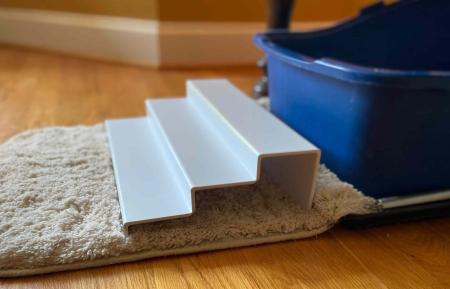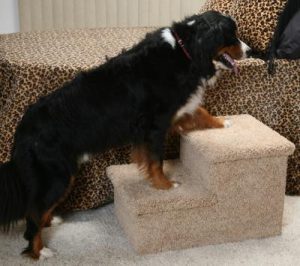Description
Why provide steps to the litter box?
As cats age, many health conditions can make accessing the litter box painful. Joint pain, tumors, and injuries can all make climbing into the box uncomfortable enough that many cats begin peeing outside the litter box. They may begin to associate the litter box with the pain and start avoiding the box altogether.
Once litter box avoidance begins, it can be difficult to encourage cats to resume use. We recommend providing steps to support access before any avoidance issues start. These steps are custom-designed and made in the USA from white, non-toxic HIPS (high impact poly styrene). Their size is perfect to provide low-rise, wide, stable steps for cats to access the litter box.
We made the design simple, to keep the steps easy to clean. However, you may wish to visit your local hardware store to add non-slip tape to the treads or grips to the bottom, if that works better for your cat.
How to Use:
Simply place the steps on a non-slip rug or mat in front of your cat’s normal access point for his litter box. The rug or mat helps keep the steps from sliding and has the added benefit of capturing some of the inevitable litter residue as your cat exits the box.
Features:
- Sturdy, non-toxic set of low-rise steps makes it easy for your cat to climb into the litter box, reducing painful leg and hip movements.
- Made in USA from white HIPS (high impact poly styrene)
- Nonporous and lightweight, yet sturdy and supportive
- Simple to use: Position steps at cat’s normal access point to litter box on a rug or non-slip surface.
- High Impact Polystyrenes are non-toxic materials, and they do not harm the environment.
- High Impact Polystyrenes are widely used in the food industry because they are hygienic materials
- Does not contain BPA or phthalates
- Easy to recycle
- For indoor use only
- Weight: 2.2125 lbs.
Dimensions:
14.5 inches wide X 9 inches deep X 3.75 inches tall
Cleaning:
We recommend cleaning using a microfiber cloth with mild soap and water. Harsh detergents and solvents can damage the surface.
Important: If your cat has started peeing outside the litter box, you should definitely schedule an examination with your veterinarian to determine if there is a medical issue. There are many reasons a cat may begin peeing outside the litter box.
More Resources:
For more information on how you can help as your cat ages, please read Cats Often Suffer Silently From Joint Pain — Here are 8 Ways You Can Help
For more tips on caring for your older cat, read Caring for Older Cats, by renowned cat behavior expert, Pam Johnson-Bennett








Karen Benedict –
Customer service is fantastic. Very knowledgeable and helpful. Great people to deal with. Thank you so much!